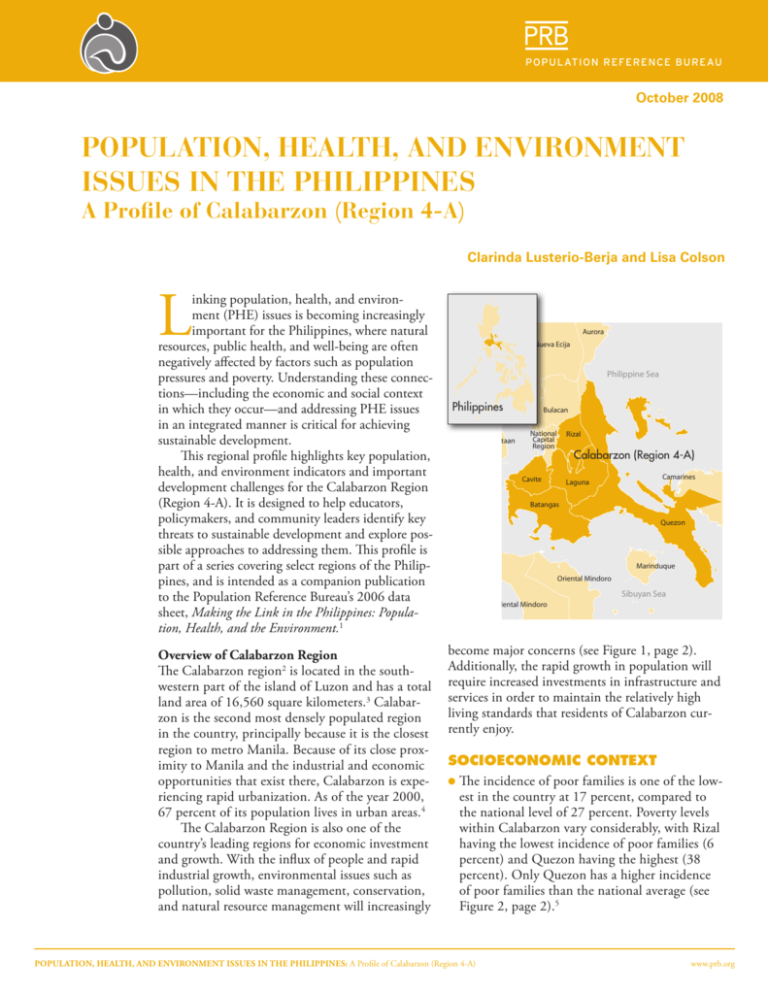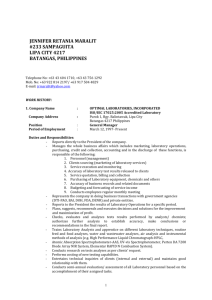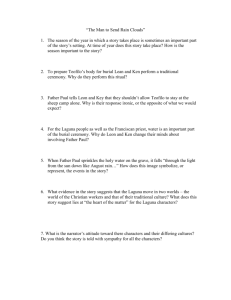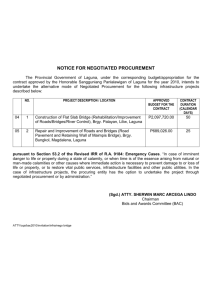
PO PULATI O N REF ERENCE BUREAU
October 2008
Population, Health, and Environment
Issues in the Philippines
A Profile of Calabarzon (Region 4-A)
Clarinda Lusterio-Berja and Lisa Colson
L
inking population, health, and environment (PHE) issues is becoming increasingly
important for the Philippines, where natural
resources, public health, and well-being are often
negatively affected by factors such as population
pressures and poverty. Understanding these connections—including the economic and social context
in which they occur—and addressing PHE issues
in an integrated manner is critical for achieving
sustainable development.
This regional profile highlights key population,
health, and environment indicators and important
development challenges for the Calabarzon Region
(Region 4-A). It is designed to help educators,
policymakers, and community leaders identify key
threats to sustainable development and explore possible approaches to addressing them. This profile is
part of a series covering select regions of the Philippines, and is intended as a companion publication
to the Population Reference Bureau’s 2006 data
sheet, Making the Link in the Philippines: Population, Health, and the Environment.1
Overview of Calabarzon Region
The Calabarzon region2 is located in the southwestern part of the island of Luzon and has a total
land area of 16,560 square kilometers.3 Calabarzon is the second most densely populated region
in the country, principally because it is the closest
region to metro Manila. Because of its close proximity to Manila and the industrial and economic
opportunities that exist there, Calabarzon is experiencing rapid urbanization. As of the year 2000,
67 percent of its population lives in urban areas.4
The Calabarzon Region is also one of the
country’s leading regions for economic investment
and growth. With the influx of people and rapid
industrial growth, environmental issues such as
pollution, solid waste management, conservation,
and natural resource management will increasingly
Aurora
Nueva Ecija
Tarlac
Philippine Sea
Pampanga
Philippines
Bataan
South
China
Sea
Bulacan
National
Capital
Region
Rizal
Calabarzon (Region 4-A)
Cavite
Laguna
Camarines
Batangas
Quezon
Marinduque
Oriental Mindoro
Sibuyan Sea
Occidental Mindoro
become major concerns (see Figure 1, page 2).
Additionally, the rapid growth in population will
require increased investments in infrastructure and
services in order to maintain the relatively high
living standards that residents of Calabarzon currently enjoy.
Socioeconomic Context
l The incidence of poor families is one of the lowest in the country at 17 percent, compared to
the national level of 27 percent. Poverty levels
within Calabarzon vary considerably, with Rizal
having the lowest incidence of poor families (6
percent) and Quezon having the highest (38
percent). Only Quezon has a higher incidence
of poor families than the national average (see
Figure 2, page 2).5
Population, Health, and Environment Issues in the Philippines: A Profile of Calabarzon (Region 4-A)
www.prb.org
2
l As
of 2006, Calabarzon’s per capita gross regional
domestic product at constant 1985 prices was
14,437 pesos, very close to the national average
of 14,676 pesos.6
l Calabarzon
has an unemployment rate of 9.4
percent, the second highest in the Philippines
next to the National Capital Region (NCR).7
l The
net enrollment ratio in primary education
for Calabarzon is 98 percent, the highest in
the nation.8
l Eighty-five
percent of families in Calabarzon
have access to safe drinking water, higher than
the national average of 80 percent. Most Calabarzon families (91 percent) also have sanitary
toilets, compared with only 86 percent of families in the Philippines overall.9
Annual population growth rate (2000-2007)
Average births per woman (total fertility rate) (2003)
Married women ages 15-49 using contraception
(2003)
Unmet need for family planning (2003)
Infant mortality rate (2006)
Forest cover (2002)
Number of threatened animal species (2004)
Protected areas (2004)
Per capita gross regional domestic product at constant
1985 prices (2006)
the year 2025, the Calabarzon region is
expected to grow to approximately 16 million
people.10 The province of Cavite is projected to
have the largest share of the region’s population
since it will absorb the spillover of population
from NCR (see Figure 3, page 3).
percentage of Calabarzon’s population living
in urban areas is now 67 percent and rapidly
increasing due to its growing economy and inmigration. The province of Rizal has the largest
urban population at 96 percent, while Quezon
has the smallest at 22 percent.11
l Married women in Calabarzon have 3.2 children on
PHE INDICATORS FOR REGION 4-A
Population density (2007)
l By
l The
Figure 1
Population (2007)
Demographic and
Health Trends
With a population of 11.7 million, the Calabarzon
Region now has the largest population in the country, surpassing the NCR since the 2000 Census.
The region is also the second most densely populated region, with 709 people per square kilometer.
11,743,110a
709 people per sq. km.b
3.2%c
3.2
33% (any method)
48% (modern method)d
16%
20 infant deaths per 1,000
live birthse
55%
35
average, slightly less than the national total fertility
rate of 3.5. There is a consistent gap between wanted
and actual fertility in Calabarzon. On average, women are having about one child more than they would
like (actual fertility 3.2 vs. wanted fertility 2.3).12
l Forty-eight
percent of married women in Calabarzon use some form of contraception, while
one-third of married women in Calabarzon use
modern contraception. This is comparable to the
Figure 2
INCIDENCE OF POOR FAMILES, 2006
75,167 hectares
f
Rizal
14,437 pesosg
National Statistics Office (NSO), “2007 Census of Population”, accessed online at www.census.gov.ph/
census2007/index.html, on April 14, 2008.
b
Calculated by PRB.
c
NSO, “2007 Census of Population,” accessed online at www.census.gov.ph/data/census2007/index.html, on
May 20, 2008.
d
NSO and ORC Macro, Philippines National Demographic and Health Survey 2003.
e
Department of Environment and Natural Resources, NSO, “2006 Family Planning Survey”.
f
Department of Environment and Natural Resources “Summary of Protected Areas in the Phiippines by Region: 2004,” accessed online at www.denr.gov.ph/section-facts-figures, on Nov. 27, 2007
g
National Statistical Coordination Board, “Regional Accounts”, accessed online at www.nscb.gov.ph/
grdp/2006/2006concap.asp, on April 14, 2008.
Quezon
a
Except where noted, data are taken from Population Reference Bureau, Making the Link in the
Philippines: Population, Health, and the Environment (Washington, DC: Population Reference Bureau, 2006).
Sour c e :
6%
Laguna
Cavite
38%
11%
8%
Batangas
Calabarzon
26%
17%
National Statistical Coordination Board, Population Projections (www.nscb.gov.ph/secstat/d_popnProj.asp, accessed Nov. 27,
2007).
Source:
Population, Health, and Environment Issues in the Philippines: A Profile of Calabarzon (Region 4-A)
www.prb.org
3
national level of modern contraceptive prevalence at
33 percent. Within Calabarzon, modern contraceptive
prevalence ranges from 28 percent in the province of
Batangas to 44 percent in Laguna (see Figure 4).
l Sixteen
percent of married women in Calabarzon have
an unmet need for family planning, meaning they
would like to wait before having more children or
would prefer to have no more children but are not using any method of family planning.
l The
infant mortality rate in Calabarzon, a key indicator
of health status, is one of the lowest in the Philippines
at 20 deaths per 1,000 live births. The national rate is
24 infant deaths per 1,000 live births.
Natural Resources and
Biodiversity Issues
The Calabarzon region has one of the most varied landscapes in the country. The topographical features consist
of flat coastal area and upland interior areas of plains,
rolling hills, and mountains. Rich in biodiversity and
attractive natural environments, the region is a favorite
destination of local tourists from nearby metro Manila.
l Based
on Department of Environment and Natural
Resource (DENR) data, there are 24 protected areas
in Calabarzon with a total area of 74,378 hectares.13
Although these areas represent a small portion of the
region’s overall land area, they help ensure the survival
of rare species and maintain the ecosystem’s services,
such as the provision of clean water.
l Calabarzon
has 55 percent of its area covered in
forest, including remote areas, urban forests, plantations, and mangroves. Mangroves (salt-tolerant
trees) are important breeding and spawning grounds
of fish and shellfish. Forest cover in general is
important for climate regulation, watershed protection, and preventing soil erosion.
l The
Philippines has more than 20,000 species found
nowhere else in the world. As of 2004, there were a total of 35 threatened animal species found in the region.
A few examples include Tamaraw (Bubalus mindorensis),
Visayan spotted deer (Cervus alfredi), white-winged
flying fox (Pteropus leucopterus), and Visayan warty pig
(Sus cebiformis), each endemic to the Philippines.14 Due
to centuries of hunting and deforestation, and more
recently urban development, large animals are now rare
and wild species are confined to the remote forest and
mountain areas in the region.
l The
region includes two of the 10 major lakes in the
Philippines: Laguna de Bay, the largest freshwater lake
in the Philippines with an area of 90,000 hectares;
and the Taal Lake in Batangas with an area of 23,400
hectares.15
Figure 4
MARRIED WOMEN AGES 15-49 USING
CONTRACEPTION, 2003
39%
Batangas
28%
48%
Quezon
Figure 3
30%
PROJECTED POPULATION OF REGION 4-A,
2005-2040
14.4
15
10
11.9
15.6
31%
18.5
16.7
17.6
50%
Cavite
35%
13.1
10.7
5
0
46%
Rizal
Millions
20
58%
Laguna
2005
2015
2025
Any method
2035
National Statistical Coordination Board, Population Projections
(www.nscb.gov.ph/secstat/d_popnProj.asp, accessed Nov. 27, 2007).
Source :
44%
Modern methods
National Statistics Office and ORC Macro, Philippines National
Demographic and Health Survey (2003).
Source:
Population, Health, and Environment Issues in the Philippines: A Profile of Calabarzon (Region 4-A)
www.prb.org
4
l Laguna
de Bay supports agriculture, industry, recreation, and ecosystem services. Fisheries production
from the lake is on the magnitude of 7.3 million pesos
per year. The Kalayaan Hydroelectric Power Station in
Laguna produces 600 megawatts of electricity.16
l Laguna
de Bay water quality is categorized as a class
C—a “good” fishery and industrial water supply—
based upon criteria for oxygen levels, organic compounds and chemicals, water clarity, and other factors.
The Laguna Lake Development Authority has maintained this water quality class over the past few years, a
success considering the increased use of the lake.
l In
2006, the World Bank reported that the rivers along
the barangays in Laguna Province, located at the west
bay of Laguna de Bay, pose a risk to public health.17
l According to the National Solid Waste Management Com-
mission, 70 percent of solid waste is collected in urban
areas of the Philippines, whereas only 40 percent is collected in rural areas. Solid waste management is necessary
to reduce ground and surface water contamination, the
spread of disease, and exposure to toxins.18 Wastes that are
not collected or are disposed of improperly, such as in open
dumpsites, pose a public health threat and contribute to
river and coastal water pollution. In Calabarzon, there are
35 open dumpsites, out of more than 200 waste management facilities.19
l In
2002, agricultural land accounted for approximately
36 percent of the region’s total land area. Between 1991
and 2002, the number of farms and agricultural land
area decreased by 12 percent and 16 percent, respectively.20 The decrease in agricultural lands is attributed
to the conversion to residential or commercial use accompanying the region’s population growth.
l Most
of the region’s productive agricultural lands are
already utilized at full capacity. Batangas and Cavite
provinces have surpassed capacity levels; that is, crop
production activities are utilizing marginal lands, including upland areas in these provinces.
l The
Calabarzon Region has 22 operating economic
zones—one government-owned and 21 private zones.
The most active economic zones, hosting thousands of
workers, are within Cavite and Laguna. This high level
of economic activity is close to two major bodies of water, Laguna Lake and Taal Lake, making them vulnerable to industrial pollutants.
l The
quantity of dissolved oxygen (DO) present in water
is a key measurement of water quality (fish and other
aquatic life need at least 5 milligrams per liter (mg/L)
of oxygen to survive). In 2003, the Imus River had a
DO level of 3.0 mg/L, but by 2005, DO levels had improved to 5.3 mg/L, an increase of 77 percent. In 2003,
the Ylang-Ylang River had a DO level of 4.5 mg/L,
which increased only slightly to 4.6 mg/L in 2005. Low
DO levels are the result of the discharge of domestic
and industrial wastes from communities and industrial
sites in the area.21
l Air
pollution contributes to cardiovascular and respiratory diseases. A key measurement of air pollution
is total suspended particulates (TSP), small solid and
liquid particulates such as dust, smoke, soot, and
acid fumes. These particulates are usually produced
by motor vehicles and fuel-burning facilities. The acceptable level of TSP is 90 µg/Ncm (micrograms per
normal cubic meter). Batangas, a city with high air
pollution based on the DENR standard, had a oneyear exposure level of 127 µg/Ncm in 2004, down
from 144 µg/Ncm in 2003. For Cavite City, the oneyear exposure of TSP was 79 µg/Ncm in 2004.22
Responding to Challenges
Calabarzon is confronted by a host of environmental
problems that threaten the health of the population. The
aggressive implementation of the Calabarzon Master Plan
supports continued economic and industrial growth in the
region. It primarily aims to catalyze development in Calabarzon to help decongest the urban NCR. The increase in
the number of industrial and technological parks, commercial complexes, and residential subdivisions are indicative
of the urban expansion in the region.
Given the trends in economic development and urbanization, two major challenges in the region are pollution
and solid waste disposal. Recognizing the interconnections
between people and their environment is therefore critical
for achieving sustainable economic development, while also
maintaining a healthy environment and ensuring the wellbeing of Calabarzon’s population. Four initiatives are highlighted below as models of success.
Laguna Lake Development Authority
Based on water quality monitoring data, a key challenge for
improving the Laguna de Bay resource is solid waste and
sanitation management. The Laguna Lake Development
Authority manages the Laguna de Bay Region and is building
partnerships with multiple stakeholders throughout the region to protect the lake and its watershed. Partnerships range
in scale from small river cleanups and tree plantings to large-
Population, Health, and Environment Issues in the Philippines: A Profile of Calabarzon (Region 4-A)
www.prb.org
5
scale projects with international partners. For example,
the Global Environment Facility of the World Bank is
financing a $5 million grant to support sewer and sanitation treatment. Even with improvements in scientific
assessments of water quality, educational outreach, and
several other activities, cleaning up Laguna de Bay will
continue to be an enormous task.23
Pollution Control Officers Initiative
Since industries are one of the major sources of pollutants in Calabarzon, the Department of Environment and Natural Resources (DENR) ventured into
a partnership with the private sector, designating
pollution control officers (PCOs) for the major
industries operating in the region. The PCOs work
closely with DENR to implement effective environmental management and protection strategies. Specifically, the PCOs are responsible for ensuring that
each company’s environmental program is designed
and implemented in accordance with environmental
regulations and standards. A total of 115 company
PCOs located in economic zones in Cavite, Laguna,
Batangas, Rizal, and Quezon provinces participate in
efforts to incorporate air quality management, water
quality management, and massive information,
education, and communication campaigns into their
company environmental programs.
Ecological waste management systems and toxic chemical and hazardous waste management have
also been implemented in the economic zones.
As of 2005, there are 34 treatment, storage, and
disposal facilities for toxic chemicals and hazardous
wastes in Calabarzon’s economic zones.24
Solid Waste Management Project
The Ecological Solid Waste Management Act of
2000, and the Local Government Code assigned
responsibility of solid waste management to municipalities and city governments. Unfortunately,
not all localities have the resources to comply with
the law. For instance, in Calamba City, the local
government could not provide solid waste management infrastructure that meets the social and environmentally sustainable standard. In response, a
DENR-United Nations Development Programme
Solid Waste Management Project involving both
the public and the private sectors was implemented. Three contiguous economically challenged
barangays in the city were chosen as the project site
due to severe solid waste management problems
and their proximity to Laguna de Bay. By 2004, the
project achieved its main objective and established
the first fully functional cluster-barangay Material
Recovery Facility in the country through a publicprivate partnership.25
This example highlights just one of numerous
achievements since the passage of the Solid Waste
Management Act in 2000. Despite these successes,
many opportunities remain for better management
of solid waste throughout the region.
World Wildlife Fund (WWF)-Philippines
Marine Conservation Project
Successful initiatives have not focused solely on
pollution, but have also worked on the protection
of biodiversity in marine ecosystems. Two local
government units in Batangas, in collaboration
with WWF-Philippines, have organized a coastal
resources project financed almost entirely by marine
user fees. The Marine Law Enforcement Campaign
was launched in 2003 and has reduced illegal fishing and restored coral cover and fish populations.
Since its inception, the system has continuously
supported the protection of biodiversity in the area
and has benefited local fishermen and divers through
increased fish catches and enhanced diving experiences. In this system, multiple stakeholders decide
on the use of funds and provide oversight to ensure
transparency and accountability.26
The cases described above illustrate the need for
collaboration between national and local governments,
civil society, and the private sector to ensure effective
and sustainable projects. An increased understanding
of the connections between population, health, and
the environment will lay the foundation for more effective, participatory development efforts that increase
human well-being and sustain healthy environments.
References
1
Population Reference Bureau, Making the Link in the Philippines: Population, Health, and the Environment (Washington,
DC: Population Reference Bureau, 2006).
2
Calabarzon is also referred to as Region 4-A. Previously,
Calabarzon and Mimaropa comprised Region 4, also known as
Southern Tagalog, until they were separated in May 2002.
3
National Statistical Coordination Board (NSCB), “Regional,
Region IV-A: Calabarzon,” StatWatch, (June 2007), accessed
online at www.nscb.gov.ph/ru4/statwatch/2007/sw2Q07c.pdf,
on April 16, 2008.
Population, Health, and Environment Issues in the Philippines: A Profile of Calabarzon (Region 4-A)
www.prb.org
6
National Statistics Office (NSO), “Table 1. Number and Percent of
Urban Population,” accessed online at www.census.gov.ph/data/sectordata/2003/pr0382.htm, on Feb. 5, 2008.
5
NSCB, Poverty Statistics, accessed online at www.nscb.gov.ph/
poverty/2006_05mar08/table_1.asp, on May 14, 2008.
6
NSCB, Economic Regional Accounts, accessed online at www.nscb.gov.
ph/grdp/2006/2006concap.asp, on April 14, 2008.
7
NSO, “Table C. Labor Force Participation Rates by Region: January
2008,” accessed online at www.census.gov.ph/data/sectordata/2008/
lf080121.htm, on May 20, 2008.
8
NSCB, Net Enrollment Ratio In Primary Education By Region and
Year, accessed online at www.nscb.gov.ph/imdgs/index.asp, on April 8,
2008.
9
National Economic Development Authority, Development Advocacy
Factsheet, No. 29 (June 2005).
10
NSCB, Population Projections, accessed online at www.nscb.gov.ph/
secstat/d_popnProj.asp, on Nov. 27, 2007.
11
NSO, Urban Population Press Release (Oct. 10, 2003), accessed
online at www.census.gov.ph/data/sectordata/2003/pr0382.htm, on
May 20, 2008.
12
NSO and ORC Macro, Philippines National Demographic and
Health Survey (2003).
13
Department of Environment and Natural Resources (DENR) “Summary of Protected Areas in the Philippines by Region: 2004,” accessed
online at www.denr.gov.ph/section-facts-figures, on Nov. 27, 2007
14
DENR Calabarzon Region, “Compendium of ENR Information
and Statistics, CY 2006,” accessed online at http://calabarzon.denr.
gov.ph/, on May 4, 2008.
15
Bureau of Fisheries and Aquatic Resources, http://region4a.bfar.
da.gov.ph/regional_profile.htm.
16
Laguna Lake Development Authority, Laguna de Bay Environment
Monitor 2007, accessed online at www.llda.gov.ph/LDBEMonitor
2007/LDBEMonitor2007.pdf, on June 8, 2008.
17
World Bank, “Water Pollution, Sanitation and Health,” in Philippines Environment Monitor 2006: Environmental Health (Philippines:
The World Bank, June 2007), accessed online at http://go.worldbank.
org/TNFDMS69D0.
18
World Bank, “Brown Environment,” in Philippines Environment
Monitor 2004: Assessing Progress (Philippines: The World Bank, December 2004).
19
National Solid Waste Management Commission, “ESWM Facilities,” accessed online at http://eia.emb.gov.ph/nswmc/REC%20-%20
Web/ESWM%20Facilities1.htm on June 8, 2008.
20
NSO, “A Review of the Agriculture Sector in Calabarzon,” accessed
online at www.census.gov.ph/data/sectordata/sr04122tx.html, on Nov.
30, 2007.
21
Environmental Management Bureau of DENR, “National Quality
Status Report 2001-2005,” accessed online at www.emb.gov.ph/
wqms/2001-2005%20NWQSR/NWQSR%20-%20Body.pdf, on
Nov. 30, 2007.
4
Environmental Management Bureau of DENR, “National Air
Quality Status Report 2003-2004,” accessed online at www.emb.gov.
ph/eeid/publicationfiles/statreport04content.pdf, on Nov. 27, 2007.
23
Laguna Lake Development Authority, Laguna de Bay Environment
Monitor 2007.
24
Official Philippines government website, “115 Pollution Control
Officers Vow To Protect Environment,” Sept. 5, 2005, accessed online
at www.gov.ph/news/default.asp?i=13074, on April 8, 2008.
25
Water Environment Partnership in Asia, “Public and Private Sectors
Convergence for Solid Waste Cogovernance in Urban Poor Communities in Calamba City,” accessed online at www.wepa-db.net/policies/
cases/philippines.htm, on April 8, 2008.
26
World Wide Fund for Nature, “Mabini-Tingloy Marine Biodiversity Conservation Project,” accessed online at www.wwf.org.ph/about.
php?pg=wwd&sub1=00017, on June 8, 2008.
22
Acknowledgments
Clarinda Lusterio-Berja, College of Social Sciences and
Philosophy, University of the Philippines, and Lisa Colson, Population Reference Bureau, prepared this profile.
We gratefully acknowledge the assistance of individuals
who reviewed and commented on this profile, including several members of the Philippines PHE network
and staff at PRB. This work was made possible through
the generous support of the David and Lucile Packard
Foundation.
©2008, Population Reference Bureau. All rights reserved.
PRB’s Population, Health, and Environment (PHE)
Program works to improve people’s lives around the
world by helping decisionmakers understand and address
the consequences of population and environment interactions for human and environmental well-being. The PHE
Program engages in similar activities in other countries
and regions around the world. For more information on
PRB’s PHE Program, please write to popref@prb.org.
The Population Reference Bureau informs people
around the world about population, health, and the
environment, and empowers them to use that information
to advance the well-being of current and future generations. For more information, including membership and
publications, please contact PRB or visit our website: www.
prb.org.
POPULATION REFERENCE BUREAU
1875 Connecticut Ave., NW, Suite 520 | Washington, DC 20009-5728
Tel: 202-483-1100 | Fax: 202-328-3937 | E-mail: popref@prb.org | www.prb.org
Population, Health, and Environment Issues in the Philippines: A Profile of Calabarzon (Region 4-A)
www.prb.org








